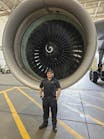Boom Supersonic Loses Engine Manufacturer. What That Means for the Jet Maker
Boom Supersonic will need a new engine manufacturer as it moves forward with plans to create a pioneering commercial supersonic jet in North Carolina.
Last week, Rolls-Royce announced it is ending its partnership with Boom, a Colorado-based company that has received more than $121 million in state and Guilford County incentives to build an assembly and testing facility at the Piedmont Triad International Airport.
Boom has committed to employ more than 1,750 people and invest $500 million in the site by the end of the decade. The plan is for the Piedmont facility to produce the Overture, Boom’s prospective slender-nosed, four-engine passenger aircraft that could cruise at 1,300 mph over water and 770 mph over land.
Boom and the London-based Rolls-Royce agreed in the summer of 2020 “to work together to identify a propulsion system that would complement Overture’s airframe,” a Boom statement said at the time.
But the partnership will not be moving forward, and both sides gave statements hinting they instigated the split. Reporting from the aviation-focused news outlet AIN Outline indicates it was Rolls-Royce who initiated the breakup.
Rolls-Royce spokesperson Donald Campbell said in a statement to The News & Observer that “after careful consideration, Rolls-Royce has determined that the commercial aviation supersonic market is not currently a priority for us.”
Boom spokesperson Aubrey Scanlan said in an email, “We are appreciative of Rolls-Royce’s work over the last few years, but it became clear that Rolls’ proposed engine design and legacy business model is not the best option for Overture’s future airline operators or passengers.”
Scanlan added Boom will announce a new engine partner “later this year.”
‘Can be a major hiccup’
Despite switching engine manufacturers, Scanlan said the Overture is still on pace to carry passengers by 2029. Among the company’s current contracts include deals to sell a select number of Overtures to United Airlines (15 airliners) and American Airlines (20 airliners) when they become available.
Yet one aviation expert says losing an engine partnership could be a major obstacle for a supersonic jet manufacturer that has yet to achieve its goal of creating a quiet, sustainable final aircraft.
“Essentially you design an airplane around your engine,” said Janet Bednarek, an aviation historian and professor at the University of Dayton. “To not have the engine you had been planning on is something of a hiccup, and can be a major hiccup.”
Bednarek said engines and the aircraft frames are typically designed in tandem, meaning a change in engines could necessitate other changes. She questioned whether a large number of engine manufacturers will jump at the chance to make a supersonic jet engine, a highly specialized product for a still-unproven market.
“Not knowing how many are going to be sold, finding a new partner could be somewhat challenging,” she said.
©2022 The News & Observer. Visit at newsobserver.com. Distributed at Tribune Content Agency, LLC.



